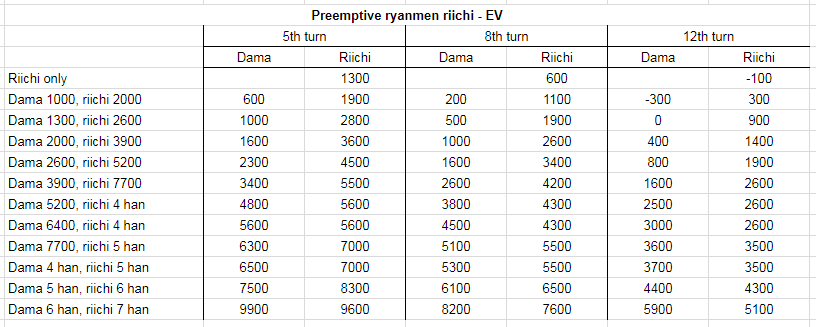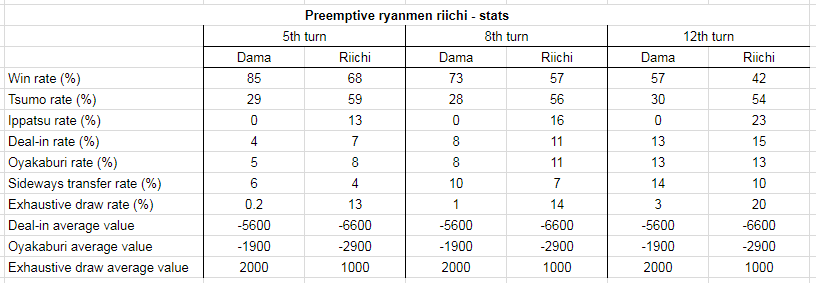Rules for Riichi
Following on from Rosti’s introduction to riichi strategy, I thought I’d present a more in-depth examination of the topic. Today’s lesson will present some strategy backed by statistics, courtesy of Meaning’s latest book 「統計学」のマージャン戦術 (Toukeigaku no Maajan Senjutsu).
Expected Values
Judging when to declare riichi is one of the most important aspects of push/fold strategy. Fundamentally, it’s a decision about whether to maximise the value of your hand or whether to maximise your chances of winning. Given the choice between a 25% chance at winning 8000 points and a 75% chance of winning 2000 points, what should you do?
This is where the concept of expected value comes in. The expected value (EV) of an outcome is its probability multiplied by it’s value – in this case, the EV for the choices above are:
- 25% x 8000 = 2000 points
- 75% x 2000 = 1500 points
As you can see, the first choice has the higher EV. This concept of maximising EV is the key foundation of what’s called digital mahjong strategy. Of course, this is easier said than done. How do you know what your chances are of winning a hand?
Fortunately, by analysing large numbers of previous games, one can calculate the rates of occurrence and resulting values for hands in certain situations. This is what allows us to extrapolate our coveted expected values.
In order to determine what separates a good riichi from a bad one, there are a few things we need to take into consideration. These are:
- Your hand value
- How good your wait is
- What turn number it is
Value versus win rate
As you know, riichi raises your hand value by adding an extra han, plus any bonuses such as ippatsu or uradora. In exchange, everyone knows that you’re ready to win, and assuming you’re playing against people who know what they’re doing, people will probably be careful not to deal into you. The result is that your win rate decreases, which affects the expected value of your hand.
So how do you balance the added value with the decrease in win rate? Between riichi and dama, which one gives higher EV? Let’s take a look at the following chart to find out.
As you can see from these statistics, with bigger hands, the increase in value from riichi becomes less important and the win rate becomes more important. For a ryanmen tenpai, that turning point comes when you’ve got a hand that’s worth 6400 without riichi, or 5200 at the 12th turn. If you have a hand that size or larger, you should stay dama to maximise your win rate. For anything smaller, you should declare riichi immediately.
What about non-ryanmen hands? Many people are reluctant to declare riichi with bad waits like kanchan or penchan, but check out this chart.
Ignoring riichi-only hands for now, it’s very important to note that your expected value is higher if you riichi with at least one other han. As I’ve mentioned in other articles, riichi and tsumo with one other han (that’s not pinfu) is the easiest shortcut to mangan. Kanchan with one dora? Riichi!
On the other end of the scale, you can see that the expected values for riichi and dama even out with a hand worth 5200 before riichi. At this point, either choice is more or less fine, but this is where you should consider other factors such as the point situation and what round it is. If it’s still early in the match or if you’re behind in points, you’re better off declaring riichi to aim for mangan. If you’re in the lead or if the other players are showing signs of danger, then you should dama.
Danger ahead?
Now, some people don’t like calling riichi because that leaves them defenseless if someone else calls riichi after them. But though these things happen from time to time, you shouldn’t worry about it. Take a look at the following chart:
You don’t have to worry too much about most of these figures, but pay attention to the deal-in rate and the mangan deal-in rate. As the statistics show, declaring riichi doesn’t actually raise your chances of dealing in by much, and your chances of dealing into a mangan after riichi are only about 3%.
Incidentally, this chart also shows that declaring riichi only decreases your win rate by about 20% or less, which is probably a lot less than many people expect. For a ryanmen tenpai, the difference in win rate is only 15-17%, as you can see in the chart below.
What if there’s competition?
One more important lesson for today – up until now, the statistics have all been based on the premise that you’re the first one to reach tenpai. However, in a four player game, this will only be the case about 25% of the time. What do you do when someone else declares riichi first?
The first rule of thumb to remember is that if you’re not tenpai, you should probably fold. If you are tenpai, then you should consider whether or not your hand is worth pushing. To do this, you need to first understand what your opponent’s expected value is, not just your own.
This might sound difficult, and it’s not really possible to know how much a riichi hand will be worth, but it’s possible to make approximations. Statistical research by HAZ (translated here) provides estimates for the size of riichi hands based on how many dora are visible, and this provides a good starting point. For simplicity’s sake we’ll round the numbers and assume that an average dealer riichi is worth about 9000 points, and an average non-dealer riichi is worth about 6000 points, subject to change depending on how many dora you can see.
To decide whether or not our hand is worth pushing, we then apply Fukuchi’s half-value rule – if you have a good wait and your EV is at least half of your opponent’s, then you can push. Combining this rule of thumb with HAZ’s expected values tells us that in order to push against a dealer riichi, our hand needs to be worth at least 4500 points and have a good wait. For a non-dealer riichi, we need a hand worth at least 3000 points with a good wait. If you have a bad wait, then your EV needs to at least match theirs. If you can’t meet these conditions, the risk of dealing in outweighs the potential gain from pushing your hand.
Don’t forget the points in the pot
One last thing to remember is that the presence of riichi sticks or honba in the pot affect the EV of your hand. To give an unlikely example, you would want to dama a pinfu-only hand if there were five riichi sticks in the pot. Similarly, if there are three riichi sticks in the pot and you have a good wait, you can justify pushing against a non-dealer riichi with a riichi-only hand. Honba affect your EV too, but they also affect your opponents’ EVs since you’ll have to pay more if you deal in!




Just found this site, and I have to say… I love you. Finding strategy resources for Riichi Mahjong in Japanese is quite hard, so thank you for all the hard work you put into these posts!
Keep up the good work!